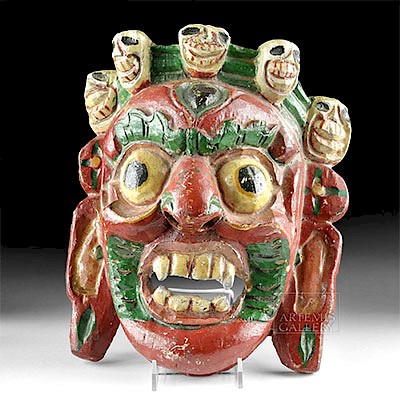Enormous Veracruz Pottery Standing Figure w/ TL
Lot 104j
About Seller
Artemis Fine Arts
686 S Taylor Ave, Ste 106
Louisville, CO 80027
United States
Selling antiquities, ancient and ethnographic art online since 1993, Artemis Gallery specializes in Classical Antiquities (Egyptian, Greek, Roman, Near Eastern), Asian, Pre-Columbian, African / Tribal / Oceanographic art. Our extensive inventory includes pottery, stone, metal, wood, glass and textil...Read more
Estimate:
$8,000 - $12,000
Absentee vs Live bid
Two ways to bid:
- Leave a max absentee bid and the platform will bid on your behalf up to your maximum bid during the live auction.
- Bid live during the auction and your bids will be submitted real-time to the auctioneer.
Bid Increments
| Price | Bid Increment |
|---|---|
| $0 | $25 |
| $300 | $50 |
| $1,000 | $100 |
| $2,000 | $250 |
| $5,000 | $500 |
| $10,000 | $1,000 |
| $20,000 | $2,500 |
| $50,000 | $5,000 |
| $100,000 | $10,000 |
| $200,000 | $20,000 |
About Auction
By Artemis Fine Arts
Apr 25, 2019
Set Reminder
2019-04-25 10:00:00
2019-04-25 10:00:00
America/New_York
Bidsquare
Bidsquare : Pre-Columbian | Tribal | Ethnographic
https://www.bidsquare.com/auctions/artemis-gallery/pre-columbian-tribal-ethnographic-4035
Featuring ancient and ethnographic art from around the world, including Pre-Columbian, Native American, African / Tribal, Ethnographic, Spanish Colonial, Fossils, Fine Art, much more. Artemis Fine Arts info@artemisfinearts.com
Featuring ancient and ethnographic art from around the world, including Pre-Columbian, Native American, African / Tribal, Ethnographic, Spanish Colonial, Fossils, Fine Art, much more. Artemis Fine Arts info@artemisfinearts.com
- Lot Description
Pre-Columbian, Gulf Coast of Mexico, Veracruz culture, ca. 500 to 700 CE. A massive ceramic standing figure, depicting a female shaman figure with a caiman headdress. The woman wears an elaborate piece of clothing - a skirt that flows to the floor, with her feet peeking out underneath it. Above that, several strips of applied clay connect to a high waist band. She also wears flaring, three-dimensional sleevecaps, and ropelike strips of clay wrap around the shoulders and form decoration on applied squares of clay that cover her breasts. Thick armlets and bracelets complete the decoration on her body. Her hands are held upright. Size: 17.5" W x 28.25" H (44.4 cm x 71.8 cm)
Her head, large relative to her body, is slightly tilted up, her mouth open as if she is declaring something. She wears huge spool earrings and her headdress is the upper part of an alligator or caiman's head and jaw, with the fierce teeth framing her forehead. Thick black pigment decorates her upper body, armlets, irises of her eyes, and forms a thick square around her mouth and covering her chin. The face and ear spools of this figure look similar to a sculpture from El Zapotal, an archaeological site south of Veracruz city that consists of a mound covering a shrine dedicated to the Lord of the Underworld, full of life-sized, hollow clay sculptures.
The large scale, hand-modeled figures from Veracruz are known as Remojadas, from the region in Mexico where they are found. They are usually portrayed with their arms up and most are female, as with this figure. They are made in parts, with the head added to the body using further clay that is smoothed over the neck line. Excavations revealed two types of impressive, detailed pottery figures from the Veracruz area: the Sonrientes, the joyous "smiling faces", and figures like this one, more serious, mostly adult figures, with elaborate costumes, themes, and sometimes props that all seem to point towards religious or political ceremonies. These figures are often found with the bodies smashed into pieces and the heads largely intact - they were ritually destroyed as burial offerings. Their clothing suggests that they depict people of import in society, maybe priests or nobility.
This piece has been tested using thermoluminescence (TL) analysis and has been found to be ancient and of the period stated. A full report will accompany purchase.
Provenance: private southern California, USA collection, acquired in the 1970s to mid-1980s
All items legal to buy/sell under U.S. Statute covering cultural patrimony Code 2600, CHAPTER 14, and are guaranteed to be as described or your money back.
A Certificate of Authenticity will accompany all winning bids.
We ship worldwide and handle all shipping in-house for your convenience.
#141037Repaired and restored from multiple pieces. This is very well done and difficult to see. Upper part of the skirt may have some losses along it. All black pigment appears to be original.Condition
- Shipping Info
-
All shipping is handled in-house for your convenience. Your invoice from Artemis Gallery will include shipping calculation instructions. If in doubt, please inquire BEFORE bidding for estimated shipping costs for individual items.
-
- Buyer's Premium



 EUR
EUR CAD
CAD AUD
AUD GBP
GBP MXN
MXN HKD
HKD CNY
CNY MYR
MYR SEK
SEK SGD
SGD CHF
CHF THB
THB














